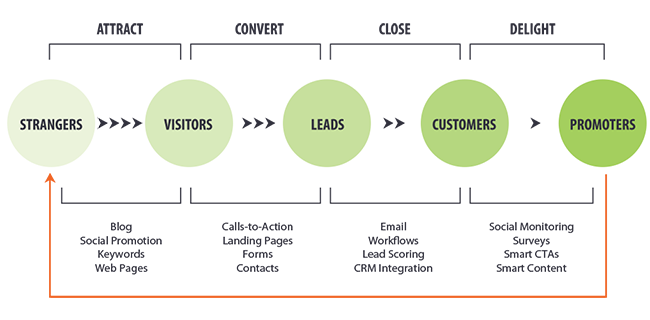.jpg)
You may well have heard of “inbound marketing” and “content marketing”.
But with the two terms so often used interchangeably, you'd be forgiven for not fully understanding what they mean, or the difference between them.
Traditional marketing doesn’t work as well as it used to. As customers, we’ve become good at ignoring a lot of marketing noise. We filter out unwanted spam, we block cold calls, and we skip television ads.
As the marketer, you used to hold all the power. Now, the control is in the hands of your customers.
This power shift is the reason inbound marketing and content marketing are terms you need to get to grips with.
What is inbound marketing?
Type ‘what is inbound marketing’ into a Google search and you’ll find various definitions. But, we find this is the clearest way to explain it:
Inbound marketing is a series of tactics that help you get found by people looking for what you do, then converting that early interest into leads and sales. Those tactics range from blogging to email to social media.
The inbound methodology is illustrated in the infographic below. Along the top are the four actions required to get visitors, leads, customers, and promoters. Along the bottom are the tactics you can use to accomplish these outcomes.

It works like this...
You attract the right people by creating content that’s valuable, relevant and easy for them to find. The tactics for attracting strangers to your site include blogging, social media, keyword optimisation and site pages.
Once you’ve got visitors to your site, the next step is to convert them into leads by gathering their contact information.
But of course, they aren’t just going to hand it over. You need to offer something in return, like an eBook. This offer is presented to visitors by way of a call-to-action at the bottom of a blog post or elsewhere on your site. A visitor clicks on the call-to-action and is directed to a landing page where they are prompted to fill out a few details in exchange for the offer. They get a helpful and relevant piece of content. You get a new lead.
Now you want to close those leads into customers. You do this with targeted, automated email nurturing and social media interactions.
But it doesn’t just end once they become a customer. You want to turn them into happy promoters of your company. You do this by using context and personalisation to deliver tailored messages that continue to engage and delight your customers. For instance, with smart content and smart calls-to-action.
What is content marketing?
Content marketing focuses on creating, publishing and distributing content for a targeted audience online.
Content can include blogs, eBooks, whitepapers, case studies. And it’s not just written content. A company may also create infographics, videos, or podcasts.
The goal is to provide your target audience with interesting, educative and helpful content, via multiple formats and channels, to position your company as the ‘go-to guys’ in your field. It’s not about creating content that simply pitches your products or services. Instead, you build trust and credibility by helping make buyers more knowledgeable.
The Content Marketing Institute (CMI) put it like this: “The essence of this content strategy is the belief that if we, as businesses, deliver consistent, ongoing valuable information to buyers, they ultimately reward us with their business and loyalty.”
A content strategy is developed based on solid understanding of your target audience. So you can create content they are searching for and that responds to their needs and wants. Content that answers a question they have at a specific point in the buyer journey, that helps them understand their pain, or helps them weigh up potential solutions.
So what’s the difference?
To keep it simple:
Inbound marketing turns strangers into visitors, leads, customers, and promoters of your company using a series of tactics.
Content marketing is a component of inbound marketing.While “inbound” and “content” marketing aren’t synonyms, nor are they fundamentally different.
They are part of the same solution: to drive business to your company.
How do they fit together?
Content can drive visitors to your website, but on its own can’t move visitors down the sales funnel to leads, to customers. That’s where inbound marketing comes in. But, there is no inbound without content.
Content marketing can exist without inbound. Even if your content doesn’t contain a call-to-action to capture leads, with the existence of a blog that generates helpful and informative content, a potential buyer may still build affinity for your brand. Then once they are ready to purchase, they’ll know where to find you.
Inbound marketing, on the other hand, needs content. But, it’s so much more than that. It equips you with a whole host of other tactics to fill your sales funnel.
What does this mean for my business?
To really deliver results, you need inbound and content marketing.
In other words, you need the whole package:
Content that informs and educates your target audience and engages them with your company.
And an inbound methodology to move people along your sales funnel from strangers to customers and promoters. Using tactics from calls-to-action, landing pages, and forms, to email marketing integration and social media sharing.
Together they can grow your presence, generate leads, create lasting relationships with customers, and get your content out there in front of your target audience.


.jpg)
.jpg)
